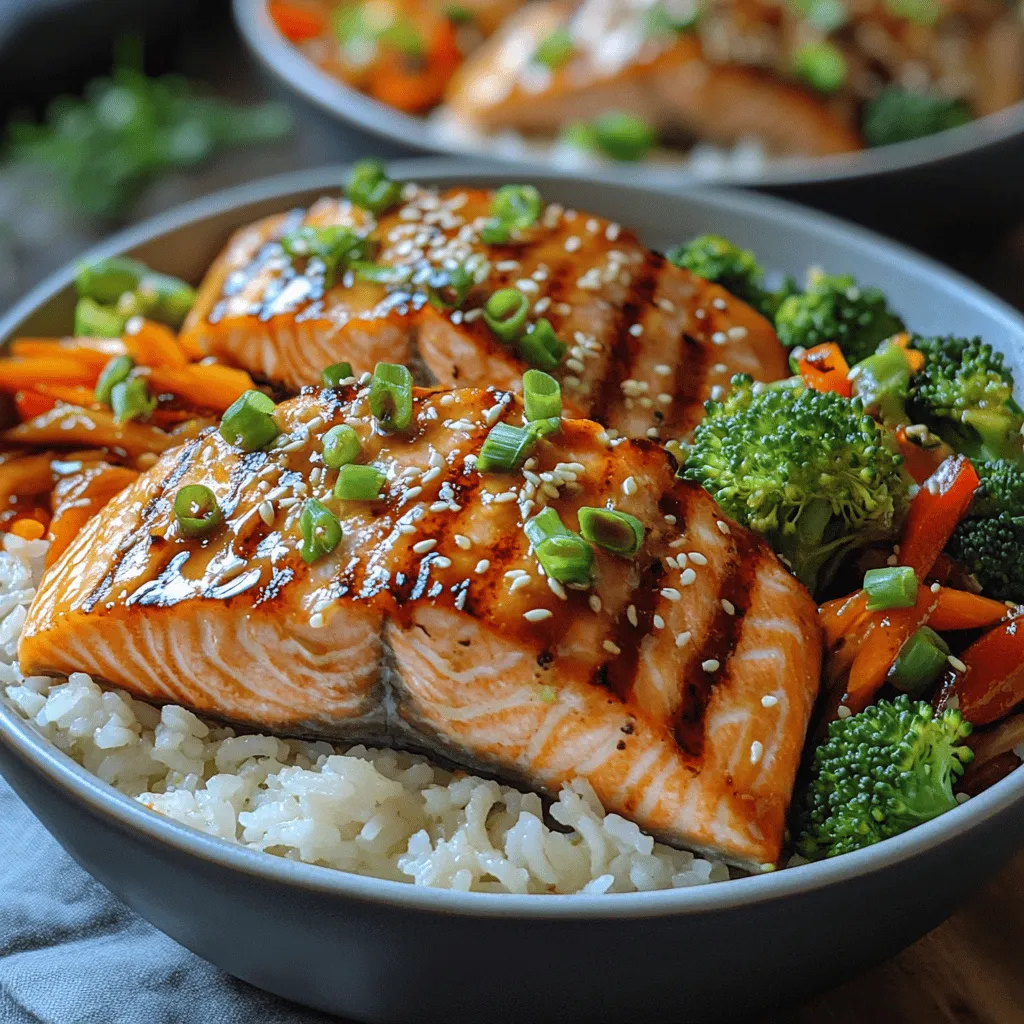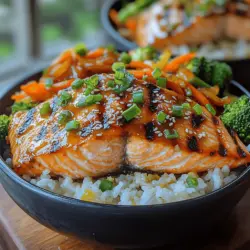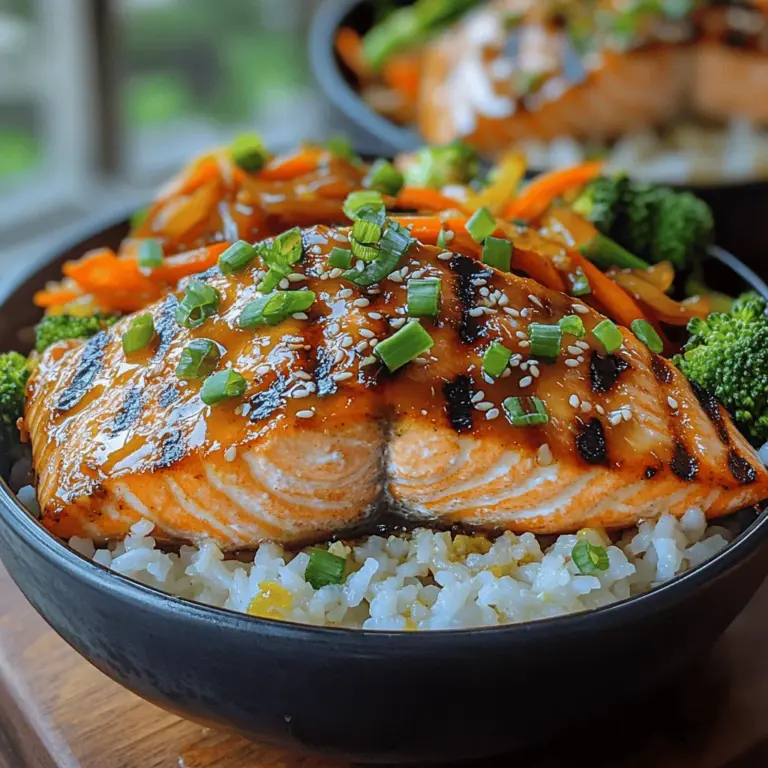Introduction
In the world of culinary delights, few dishes capture the essence of Japanese cuisine as beautifully as Teriyaki Salmon Bowls. This delightful dish marries the rich umami flavors of marinated salmon with a vibrant assortment of fresh vegetables and fluffy jasmine rice, creating a meal that is as nutritious as it is delicious. Whether you’re looking to impress guests with your cooking skills or simply want to enjoy a wholesome meal at home, the Teriyaki Salmon Bowl is both versatile and easy to prepare.
This recipe not only highlights the intricate flavors typical of Japanese cooking, but it also reflects the culture’s emphasis on fresh ingredients and balanced meals. Join us as we delve into the details of creating this savory dish, exploring its cultural background, nutritional benefits, and essential cooking techniques.
Understanding Teriyaki Sauce
The Origins of Teriyaki Sauce
To fully appreciate Teriyaki Salmon Bowls, one must first understand the teriyaki sauce that elevates this dish. The term “teriyaki” derives from the Japanese words “teri,” meaning glaze, and “yaki,” which refers to grilling or broiling. This cooking method has a rich history dating back to the early 17th century, when it was first recorded in Japan. Originally, teriyaki sauce was a simple mixture of soy sauce and sake, used to enhance the flavor of various grilled meats.
Over time, the sauce evolved to include sugar, mirin, and aromatic ingredients, creating the sweet and savory flavor profile we associate with teriyaki today. The balance of salty soy sauce and sweet sugar, along with the depth of flavor provided by garlic and ginger, offers a harmonious taste that perfectly complements the natural richness of salmon.
The Importance of Marinades in Cooking
Marinating is a culinary technique that enhances the flavor and tenderness of proteins, and it plays a crucial role in the preparation of teriyaki salmon. Marinades not only infuse the ingredients with flavor but also help to break down the meat fibers, resulting in a more tender final dish.
To create an effective marinade, it’s essential to balance the flavors and choose appropriate ingredients. In the case of teriyaki salmon, the primary components of the marinade include soy sauce for saltiness, sugar for sweetness, and aromatics like garlic and ginger for depth of flavor. Allowing the salmon to marinate for a sufficient period—typically 30 minutes to an hour—ensures that these flavors penetrate the fish, enhancing its overall taste.
Ingredients Overview
Essential Components of Teriyaki Salmon Bowls
To prepare a mouthwatering teriyaki salmon bowl, you will need the following essential ingredients:
1. Salmon Fillets: Fresh or frozen salmon works well for this recipe. The natural oils in salmon contribute to its rich flavor and moist texture.
2. Teriyaki Sauce: This can be store-bought or homemade. If you prefer to make it from scratch, a simple combination of soy sauce, sugar, mirin, garlic, and ginger will suffice.
3. Vegetables: Fresh vegetables such as broccoli, carrots, and bell peppers not only add color and visual appeal but also provide essential nutrients. Feel free to customize with your favorite vegetables!
4. Jasmine Rice: This fragrant rice is the perfect base for the dish, providing a light, fluffy texture that complements the savory salmon.
5. Sesame Seeds: For garnish, toasted sesame seeds add a nutty flavor and a nice crunch.
6. Green Onions: Chopped green onions add a fresh, vibrant touch to the finished dish.
When it comes to dietary restrictions, alternatives like tamari can be used for a gluten-free option, ensuring that everyone can enjoy this flavorful meal.
Nutritional Benefits of the Ingredients
Each component of the teriyaki salmon bowl contributes not only to the dish’s flavor but also to its nutritional value:
– Salmon: Rich in omega-3 fatty acids, salmon is renowned for its heart-healthy benefits. These essential fats support brain health and reduce inflammation, making salmon an excellent choice for a nutritious diet.
– Vegetables: Broccoli, carrots, and bell peppers are packed with vitamins and minerals. Broccoli is high in vitamin C and fiber, carrots provide beta-carotene, and bell peppers are a great source of antioxidants.
– Jasmine Rice: As a carbohydrate source, jasmine rice fuels the body with energy. It is easily digestible and complements the protein and vegetables in the dish, creating a balanced meal.
Step-by-Step Guide to Making Savory Teriyaki Salmon Bowls
Marinating the Salmon
The first step in creating your savory teriyaki salmon bowls is to marinate the salmon fillets. This process is crucial for infusing the fish with the rich flavors of the teriyaki sauce. Follow these steps for successful marination:
1. Prepare the Marinade: In a mixing bowl, combine 1/4 cup of soy sauce, 2 tablespoons of brown sugar, 1 tablespoon of mirin (or rice vinegar), 1 clove of minced garlic, and 1 teaspoon of freshly grated ginger. Whisk the mixture until the sugar dissolves completely.
2. Marinate the Salmon: Place the salmon fillets in a shallow dish or a resealable plastic bag. Pour the marinade over the fish, ensuring that each piece is well-coated. For best results, allow the salmon to marinate in the refrigerator for at least 30 minutes, or up to an hour for deeper flavor penetration.
3. Remove from Marinade: After marination, remove the salmon from the marinade and let it sit at room temperature for about 10 minutes before cooking. This step helps the salmon cook more evenly.
Cooking the Jasmine Rice
While the salmon is marinating, you can prepare the jasmine rice. Properly cooked rice serves as the perfect base for your teriyaki salmon bowl. Here’s how to achieve fluffy jasmine rice:
1. Rinse the Rice: Start by measuring 1 cup of jasmine rice. Rinse it thoroughly under cold water to remove excess starch. This step is vital for preventing the rice from becoming overly sticky.
2. Cooking Methods: You can cook jasmine rice using different methods, but a stovetop approach is often preferred for its simplicity. In a medium saucepan, combine the rinsed rice with 1.5 cups of water or chicken broth for added flavor.
3. Bring to a Boil: Place the saucepan over medium-high heat and bring the mixture to a boil. Once boiling, reduce the heat to low, cover the pot, and let it simmer for about 15 minutes. Avoid lifting the lid during cooking, as this releases steam and can affect the texture of the rice.
4. Fluff and Serve: After 15 minutes, remove the saucepan from heat and let it sit, covered, for an additional 5 minutes. Finally, fluff the rice with a fork to separate the grains before serving in your bowls.
With the salmon marinating and the rice cooking, you’re well on your way to creating a delightful teriyaki salmon bowl that is sure to impress your family and friends. In the next part of this article, we will cover the final steps of cooking the salmon, assembling the bowls, and tips for presenting this beautiful dish. Stay tuned for the continuation of this savory culinary adventure!

Preparing the Vegetables
To complement the rich flavors of teriyaki salmon, it’s essential to prepare vibrant, fresh vegetables that bring color and nutrition to your bowl. Here we’ll cover some effective techniques for steaming and stir-frying vegetables, ensuring you achieve the perfect texture and color.
Techniques for Steaming and Stir-Frying Vegetables
Steaming: Steaming is a gentle cooking method that preserves the nutrients and natural colors of vegetables. For this teriyaki salmon bowl, you might choose broccoli, snow peas, or carrots. Here’s how to steam vegetables effectively:
1. Prepare the Vegetables: Wash and chop your vegetables into uniform pieces to ensure even cooking.
2. Use a Steamer Basket: Fill a pot with a couple of inches of water and bring it to a boil. Place the steamer basket over the pot, ensuring the water doesn’t touch the vegetables. Cover with a lid.
3. Timing: Steam your vegetables for 3 to 5 minutes. Check for doneness by piercing with a fork; they should be tender yet crisp.
4. Ice Bath (Optional): To stop the cooking process and enhance color, transfer the vegetables to an ice bath immediately after steaming.
Stir-Frying: Stir-frying is another quick and flavorful way to prepare vegetables. This method allows for caramelization and enhances the overall taste:
1. High Heat Cooking: Use a wok or a large skillet and preheat over medium-high heat. Add a tablespoon of oil (such as sesame or vegetable oil).
2. Add Aromatics First: Start with garlic or ginger for flavor, cooking for 30 seconds until fragrant.
3. Add Vegetables: Introduce your vegetables gradually, starting with those that take longer to cook (like carrots) and finishing with quick-cooking items (like bell peppers).
4. Toss Frequently: Stir constantly for about 5 to 7 minutes until the vegetables are tender and have a slight char. Aim for a bright color and crisp texture.
Tips for Achieving the Perfect Texture and Color in Vegetables
– Uniform Size: Cutting vegetables into similar sizes ensures even cooking.
– Don’t Overcrowd: Give vegetables space in the pan while stir-frying to achieve that desirable char.
– Seasoning: A sprinkle of salt or a dash of soy sauce right at the end can enhance the natural flavors without overpowering them.
– Timing is Key: Always taste as you go. You want your vegetables to maintain their crunch and vibrant color.
Grilling the Salmon
Grilling or pan-searing salmon elevates its flavors beautifully, providing a smoky contrast to the sweet teriyaki sauce. Here are best practices for achieving perfectly cooked salmon.
Best Practices for Grilling or Pan-Searing Salmon
1. Preheat the Grill or Skillet: Ensure your grill or skillet is hot before adding the salmon. A preheated surface helps to achieve a nice sear.
2. Oil the Surface: Use a light coating of oil on the grill or skillet to prevent sticking.
3. Skin-On Technique: If using skin-on salmon, place the skin side down first. This helps to keep the fish moist while it cooks.
4. Cook with the Lid Closed: If grilling, close the lid to maintain heat and cook evenly.
Indicators of Perfectly Cooked Salmon: Texture and Appearance
– Color Change: Cook until the salmon turns from a translucent pink to an opaque color.
– Flakiness: Use a fork to check if the salmon flakes easily. This indicates it’s done.
– Internal Temperature: For the safest result, the internal temperature should reach 145°F (63°C). Use a meat thermometer for accuracy.
Assembling the Bowls
Now that your salmon and vegetables are ready, it’s time to assemble your teriyaki salmon bowls. Presentation plays a vital role in enhancing the dining experience.
Visual Presentation Tips for an Appealing Dish
1. Choose the Right Bowl: A wide, shallow bowl allows for better layering and visibility of ingredients.
2. Layering Ingredients: Start with a base of jasmine rice, then artfully arrange the grilled salmon and steamed or stir-fried vegetables on top.
3. Garnish Thoughtfully: Finish with sesame seeds, sliced green onions, or pickled ginger for added flavor and visual appeal.
Layering Ingredients Effectively for Balanced Flavors
– Base: Begin with a generous scoop of rice; it absorbs the teriyaki sauce and balances the flavors.
– Protein: Place the salmon off-center to create visual interest.
– Vegetables: Arrange the vegetables in a colorful manner around the salmon, ensuring a variety of textures and colors.
– Sauce Drizzle: Drizzle some teriyaki sauce over the entire bowl, but be careful not to drown the ingredients.
Exploring Flavor Combinations and Variations
While the classic teriyaki salmon bowl is delightful as is, exploring additional flavor combinations can elevate your dish to new heights.
Adding Spice to Your Bowl
For those who enjoy a little heat, consider incorporating spicy elements like Sriracha, chili flakes, or fresh jalapeños. These ingredients contrast beautifully with the sweetness of teriyaki sauce.
– Flavor Profiles that Complement Teriyaki: Ingredients like pineapple, avocado, or mango can offer a refreshing balance to the savory elements. Consider adding them as toppings for a tropical twist.
Vegetarian and Vegan Alternatives
Adapting this recipe for plant-based diets is straightforward. Here are some suggestions:
– Plant-Based Substitutes for Salmon: Consider using grilled tofu, tempeh, or even marinated eggplant as a protein alternative. These ingredients can absorb the teriyaki flavors beautifully.
– Adapting the Recipe for Different Dietary Preferences: For a gluten-free version, ensure to use tamari instead of soy sauce in the teriyaki marinade. Additionally, quinoa or cauliflower rice can serve as excellent substitutes for jasmine rice.
Cultural Significance of Teriyaki in Japanese Cuisine
Understanding the cultural roots of teriyaki enriches your cooking experience and appreciation for the dish.
The Role of Teriyaki in Traditional Japanese Meals
In Japan, teriyaki is more than just a cooking method; it is a culinary tradition that reflects balance and harmony. Typically, teriyaki dishes are enjoyed during family gatherings and celebrations, showcasing the importance of food in Japanese culture.
Variations of Teriyaki Across Different Regions in Japan
Different regions of Japan have their unique spins on teriyaki. For instance, in some areas, you may find a sweeter teriyaki sauce featuring a hint of mirin or even fruit juices. Exploring these variations allows you to appreciate the diverse flavors of Japanese cuisine.
Celebrating Japanese Cuisine at Home
Making teriyaki salmon bowls at home offers an opportunity to dive into Japanese culinary traditions. Encourage yourself and your family to explore other Japanese flavors, such as miso, dashi, or sushi-making, to embrace the richness of this culture.
The Importance of Embracing Cultural Dishes for Culinary Diversity
Cooking and sharing dishes from different cultures fosters appreciation and understanding. By preparing meals like teriyaki salmon bowls, you not only indulge in delightful flavors but also connect with the culinary heritage of Japan.
Conclusion
Savory Teriyaki Salmon Bowls are not just a meal; they are a celebration of flavor, culture, and nutrition. By mastering this dish, you embrace the rich culinary traditions of Japan while enjoying a healthy and satisfying meal. As you savor each bite, you’ll appreciate the harmony of the marinade, the freshness of the vegetables, and the comforting base of jasmine rice. This recipe stands as a testament to the beauty of home-cooked meals and the joy of sharing them with loved ones. Enjoy your culinary adventure in creating these delightful bowls and let the flavors transport you to the heart of Japan.


